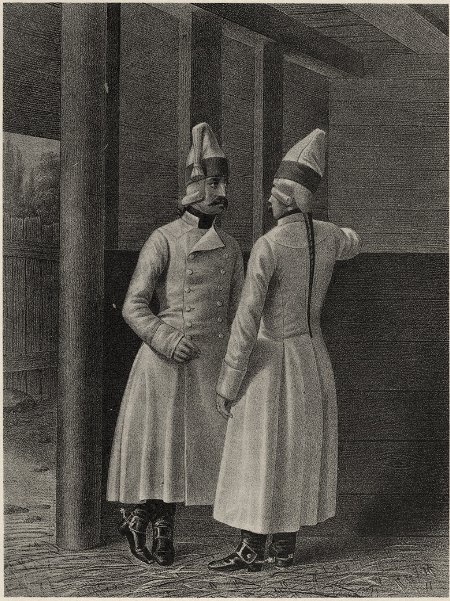
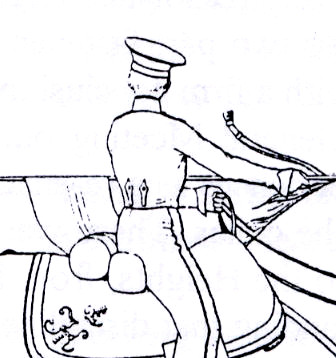
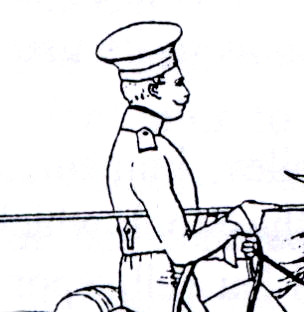
THE RUSSIAN WHITE FATIGUE SMOCK, OR KITEL’.
1. (From Sytin’s Voennaya Entsiklopediya, c, 1913)
KITEL’. As a piece of summer clothing for military personnel, the kitel’ was first authorized in 1796 for cavalry lower ranks for wear while caring for horses, and in 1802 for lower ranks in pioneer units for sapper duties. This kitel’ was a surtout [syurtuk] made of coarse white linen with long skirts almost to the ankles, double-breasted, free in the back, slightly tailored to the waist, with a standing collar and two rows of covered buttons (from the German Kittel, meaning loose overalls). In 1828 the kitel’ in the cavalry (except in the Caucasus) was replaced by a jacket [kurtka], the so-called “leibik,” but was reintroduced in 1855 (Orders No. 234 of 1855 and No. 62 of 1856). In 1860 (Order No. 78), a kitel’ was introduced for officers but of the pattern for officer’s frock coats. In 1881 (Order No. 140) it was permitted for this officer’s kitel’ to be of unbleached linen but to be worn (except in Turkestan) in only limited circumstances. In 1885 the kitel’ for cavalry lower ranks was replaced by a shirt [rubakha] (Order No. 17). From 1903 there began a gradual replacement of the dress tunic by the kitel’ in all circumstances during warm weather, and finally in 1907 (Orders No. 171, 402, and 632) a new “American” pattern kitel’ was established, single-breasted with pockets on the chest and sides, in a subdued protective color. The kitel’ in daily dress was permitted to be worn year round.



Left - Cuirassiers in the 1796 long-skirted kitel’. Right - Lancers in the leibik, or short white fatigue jacket, circa 1840.
2. (From Travels to the Seat of War in the East through Russia and Crimea in 1829, by Captain James Edward Alexander, (late) 16th Lancers. London, 1830. The extracts refer to the Russian army facing the Turks in front of Adrianople in 1829. The underlining is mine - M.C.)
(Vol. II, Page 124) The hussars commonly wore their blue braided jackets; but the lancers invariably had white linen surtouts and grey trousers: both wore oil-skin caps.
(Vol. II, Page 129-130) Count Pahlen advanced at the head of his division of five thousand men, in column: they then marched past the Field-marshal [Diebitsch]. First appeared a few hundred lancers in white; after them the hussars, with pikes, in open column of divisions...
3. (From V.V. Zvegintsov, Russkaya Armiya; chast’ 6-ya, 1855-1881. Paris. 1978. Page 642.)
5 April 1856 - For lower ranks of Guards and Army cavalry, a pattern and description of the kitel’ was confirmed (in place of the leibik), of guards Flemish linen in the Guards and of ravensduck in the Army. The pattern was like that of the dress tunic but in front on both sides were pockets with flaps, as on officers’ greatcoats, the flaps being 4-1/4 vershoks long and 3/8 vershoks wide [7-1/2 by 3/4 inches]. The length of the skirt from the waist was 8 vershoks [14 inches]. In the Guards light cavalry the collar opening was a straight diagonal, while in the Guards cuirassiers and Army cavalry it was rounded. The back skirt was slit, with the left side overlapping the right. For all the straight cuffs were 1-1/2 vershoks [2-5/8 inches] wide. Shoulder straps were of ravensduck, 1-1/2 vershoks wide. Buttons were covered, 2 rows of 8 in front for the Guards and 2 rows of 6 for the Army. Pocket flaps in the back were the same size as on the dress tunic, straight for Guards and Army cuirassiers, with 2 buttons, and scalloped for Guards and Army light cavalry, with 3 buttons.
________________________________
Translations by Mark Conrad, 2004.
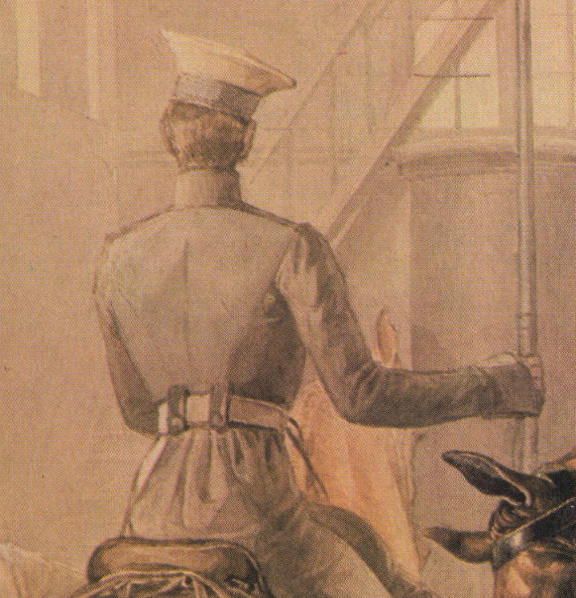
A rear view of the leibik, from a painting by Sauerweid depicting the Life-Guards Cuirassier Regiment in the 1830’s.
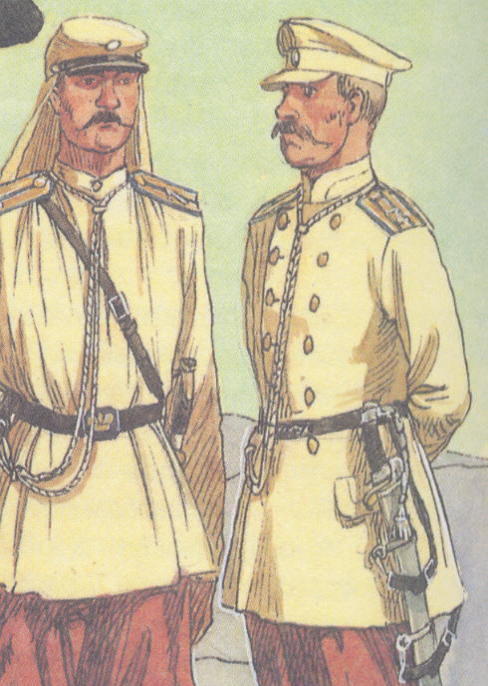
A modern sketch by Parkhaev showing officers wearing (left) the shirt and (right) the kitel’.
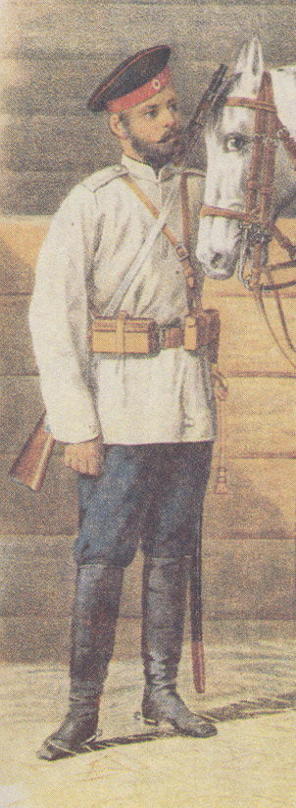 A
cavalry trooper wearing the white fatigue shirt, or gimnasterka,
around 1890.
A
cavalry trooper wearing the white fatigue shirt, or gimnasterka,
around 1890.
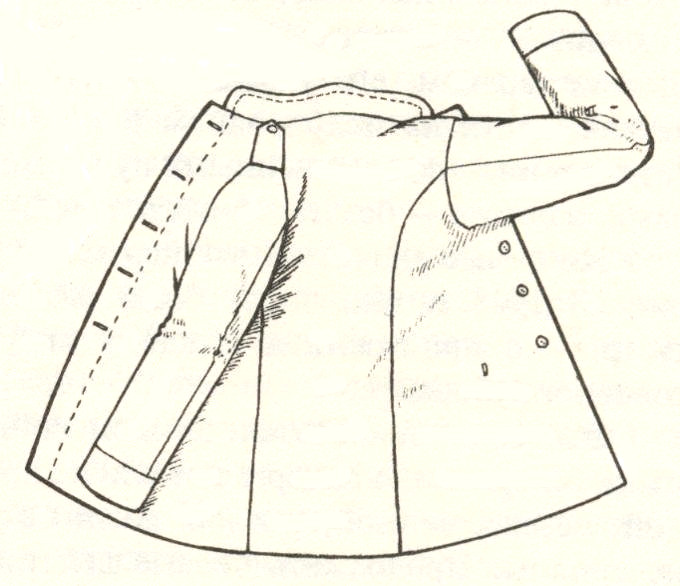
Lower ranks’ field tunic 1907-10, modern drawing by Begunova.
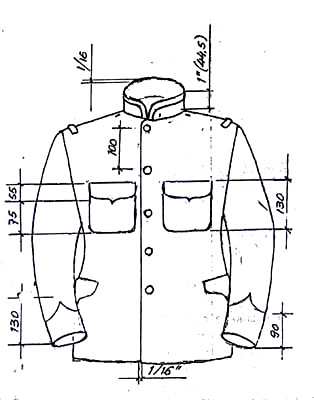
Contemporary pattern sketch of the "1909 officers’ and lower ranks’ kitel’."